-
Posts
800 -
Joined
-
Last visited
-
Days Won
5
Content Type
Profiles
News and Information
Tutorials
Product Reviews
Supplier Listings
Articles
Guitar Of The Month
Links and Resources
Forums
Gallery
Downloads
Posts posted by orgmorg
-
-
I have seen it done before. The guitar sits on the left leg, with the points wrapped around the right leg so that it is braced against sliding.
-
Thanks, man! Yeah, I'm into a wide variety of stuff, style-wise.
This is a banjo I did. The body and resonator are all Stew-Mac parts, but I built the neck. I think its the most elaborate inlay I've done.
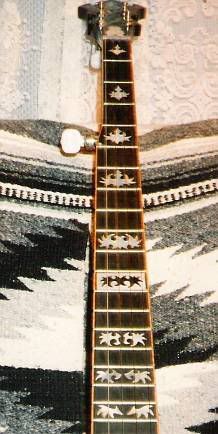
And the back:
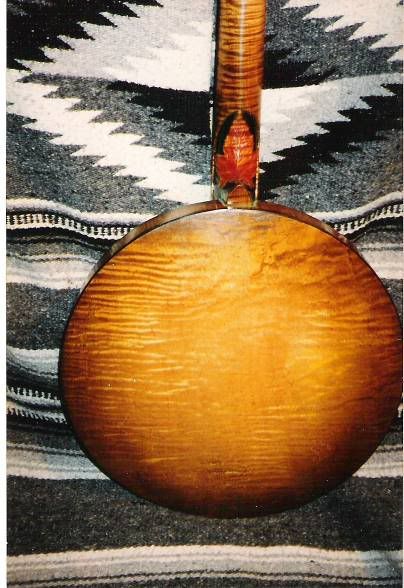
The maple leaf is relief carved into the heel, w/ the field painted black.
-
Nice Work! I just wanted to say that I like the headstock, it adds a nice touch.
 I always love the SG´s and I read somewhere that the Gibson intention was to make the SG neckthrough; I really don´t know if this is true but it seemed like a good idea and I just went for it. It´s a mix between a 61' and the P. Townshend model.
I always love the SG´s and I read somewhere that the Gibson intention was to make the SG neckthrough; I really don´t know if this is true but it seemed like a good idea and I just went for it. It´s a mix between a 61' and the P. Townshend model.If Gibson had made the SG a neck thru, there would never have been a Pete Townshend model. One of his favorite things about the SG was the way they busted in half.

-
The true character of beech comes out when it is quartersawn, as for backs and sides. the ray fleck is gorgeous. Not bold, like oak's, but subtle and lacy looking.
-
Here's a pic of the back:
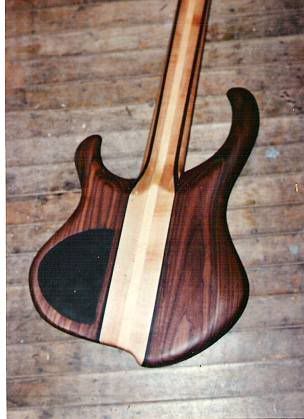
Skibum, the idea was to make it more stable, but who knows for sure? I figured at least it would look cool. The dark strips are wenge, and in retrospect, I wish I had used it for the center strip as well, or at least a piece of walnut.
Here's another oldie featuring a killer piece of hardware.
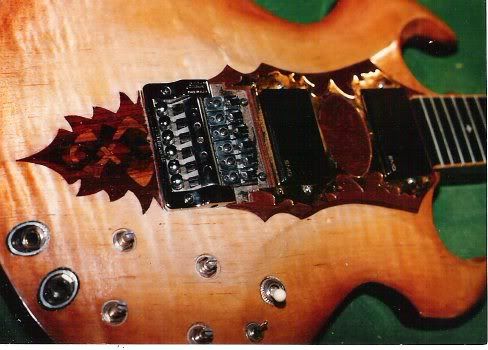
and the headstock:
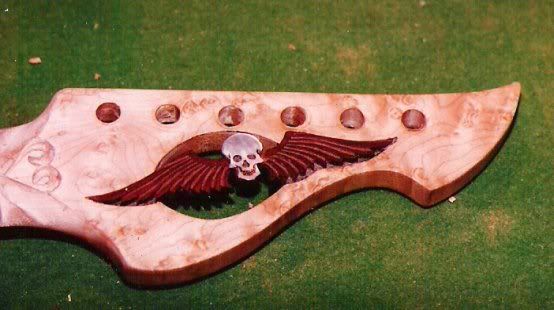
I gotta say, I'm really enjoying hanging out here, tons of good info, and a boatload of talent as well.

-
Beech is said to have excellent bending qualities, but you'd have to find a wide enough quartersawn piece to make a back. I'm gonna guess your figured piece is plainsawn? I've seen some incredible figure in old beech barn boards, up to 20"wide, but most of the commercially sold wood is very plain.
-
Thanks for the replies! I guess that means the pictures linked correctly.

The barnwood guitar sounds much like a tele, which was the intent, with a bit of beef available from the humbucker when necessary. I used a 5 position, four pole switch to get a good range of sounds. I don't have the slightest clue how to make a sound clip, but I'm willing to learn
 What do I need? Or is there something posted here somewhere on that?
What do I need? Or is there something posted here somewhere on that?Anywho, here's a couple six string, neck thru body basses from a LONG time ago, when I was not too good about documenting my work

One for the pointy guitar lovers,
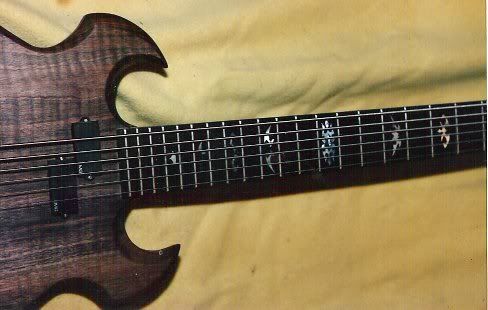
The top is a 16" wide piece of figured walnut, wish I had a better pic of it.
Made for a huge Geezer Butler fan, big bottom end.
This one is a fretless, cocobolo fingerboard w/maple fret lines. This guy was into Les Claypool.
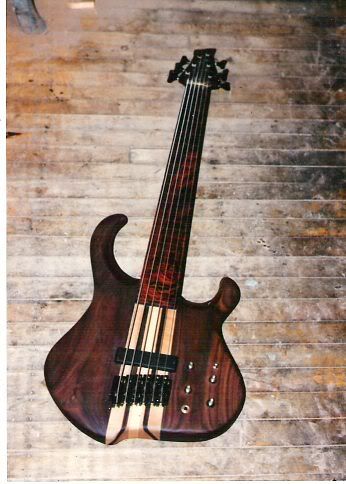
These old prints that I am scanning look better than what I take with my cheapo digital, gotta do something about that.
-
Cool, thanks. Guess I need to keep my spray room a little cleaner.

-
Also, a pinrouter spindle turns at 20,000rpm. Radial saws are around 3000-4000
-
The best advice I can give if you really want to build one from scratch, right off the bat, and are unsure of your ability, is this: Start hoarding scraps of wood, wherever you find them, furniture from the dump, whatever. Then, whatever tool or technique you need to learn, do it on that. Rout humbucker cavities in desktops, radius table legs, etc. You will be bummed if you bugger up a decent piece of wood making your first guitar... Believe me.

-
So, a satin finish gets no buffing or other such final "treatment" ?
Just spray the last coat and hope a speck of dust doesn't land on it?
That sounds almost as intimidating as buffing.

( I am still getting the hang of spray finishing here
 )
) -
I made the doors for my kitchen cabinets out of some heavily spalted maple, and didn't have any problems. I applied a waterborne polyurethane with a brush on them, though. Never sprayed any w/lacquer. What sort of finishing problems come up? The main one I can think of is the wormholes. I liked them in the doors, so I left them, but I bet they could be easily filled w/black epoxy or something.
-
Just a wacky idea that popped in my head
 for lack of a useful answer.
for lack of a useful answer. -
Hi, flood. I actually have used beech for a guitar body. Well, american beech anyways. The european beech is probably not too different. Ours is dense and heavy like hard maple, I think yours may be a bit softer, but not much. And it spalts very nicely. I have also made a neck with it, Beech shows a beautiful flake when quartersawn.
I didn't know Hagstrom used beech, thanks for that info.

-
The neutral wire in household current ( the white one ) is, or is supposed to be connected to the ground spike also. The sefety ground ( green or bare ) is there as a more direct route to earth ( ground spike ) in case a hot wire comes loose. That is why it is connected to every metal enclosure.
Since AC current reverses direction 60 times per second ( 50 in some parts of the world ) , the amp doesn't really care which wire is hot and which one is neutral, so older plugs could be plugged in either way. This was fine until you stepped up to a mike on a PA that was plugged in opposite the way your amp was.

-
What about a piece of veneer over the raised part? Might look cool. You could use almost any kind of wood you can think of.
-
Well, I must have some gaps in my brain, because I totally missed the fact that it was already glued together. ( It was way back in the first sentence of the original post- can't expect me to remember that far back.
 )
) In that case, I agree that it may be a little too fubar, especially if the gaps run all te way thru.
Don't scrap it, though. I'd say keep at it, and if you still don't like it, build another. Then at least it served as a practice piece, and the next one will be better.

-
Also, remember that part of the Strat's sound comes from the longer scale length. If you are building from scratch, no prob, but if using existing parts, you will have to modify them to get that right.
If you want to use a strat bridge, you will have to figure out how to mount it on the arched LP top, and keep the right string height.
I say go fer it! You could call it a Lespocaster... Umm well maybe not.

-
Interesting idea. I can see how you have gotten around cutting straight thru the body by arranging the cuts around the trem hole, but remember that the saw is taking out wood that you will have to replace. Also, are you losing too much of the control cavity? ( don't wanna lose control
 ) The other problems I see are that it will be way overbalanced toward the neck(s) unless you can graft a top horn on somehow to put the strap button further forward, and the bass bridge needs to go further back to make up the correct scale length. ( there may not be enough room )
) The other problems I see are that it will be way overbalanced toward the neck(s) unless you can graft a top horn on somehow to put the strap button further forward, and the bass bridge needs to go further back to make up the correct scale length. ( there may not be enough room )Other than that, I think it'd make a real cool axe!

-
This one I did more recently, mostly to work out some production ideas and such. Kept it pretty simple. One piece mahogany body, one piece birdseye maple neck w/ mesquite fingerboard.

-
That is a nice piece of poplar.
Ever seen it fresh off the sawmill?
Those darker streaks are deep black, blue, and purple against a bright green background>

I'd love to find a way to keep it like that, but it also looks great when it ages to shades of brown.
-
I've got a few pics, poor quality, but they load quick
 I'll put them here, and when I get some better ones, I'll post them in the projects board.
I'll put them here, and when I get some better ones, I'll post them in the projects board.BigD, I don't know for sure if "swamp" ash occurs around here, in Tennessee. I think it is only much further south. Our white and green ashes are a little softer than those further north, but not nearly like those that grow in the hot humid swamps.
Here's one I did a few years back:
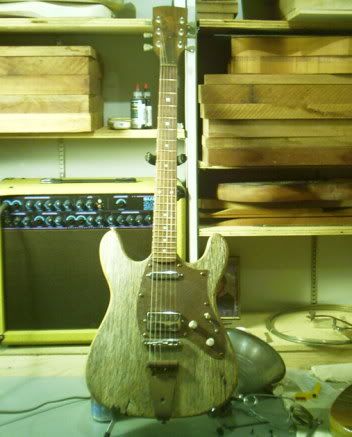
The top is cut from a piece of oak siding off an old barn and left unfinished.
The back is beech from a 2x6 in the same barn. It's heavy as a beech, too.

pickguard is rusted roof tin
tunamatic bridge
Tailpiece is a rusted iron strap hinge.
Schaller humbucker, no name tele neck pu
Grover deluxe tuners
Neck is 5 piece laminate, maple and walnut, w/ angled wormy chestnut peghead. ( the holes go all the way thru.
 )
) -
Well, ideally there should be no gaps, but if you are to the point where sanding/planing more is going to make it too small, try this: clamp it up as if you were going to glue it, but don't glue it. If the gaps close up with minimal clamping ( finger tight with just a few clamps ) you should be ok.
Attempting to fill the gaps, especially with the sawdust, will likely make things worse. If there are still tiny gaps, the glue will fill them as you clamp it. you may see a glue line, but this happens.
 Chalk it up to experience, you'll get the hang of it.
Chalk it up to experience, you'll get the hang of it.Good luck,
George
-
Howdy all,
My name is George Downing, and I am a cellulose addict. ( wood junkie )

For the past few years or so, I have been trying to get back to building guitars again. I started building when I was 14 or 15, and continued on and off until I was 21 and had to get a "real" job to support a rather unexpected wife and kid. After a bunch of moving around, different cabinet shop jobs, and ultimately another wife and kid, I am now 34 and running my own woodshop/contracting/sawmilling business. With keeping the business running enough to support all involved ( including my creditors
 ) time and energy run short for guitars. I'm hoping that hanging out here will help keep the fire lit under my bony posterior enough to keep me at it.
) time and energy run short for guitars. I'm hoping that hanging out here will help keep the fire lit under my bony posterior enough to keep me at it. 
Thanks,
George



Beech As Guitar/bass Body Wood?
in Solidbody Guitar and Bass Chat
Posted
Wow, that's nice!
I had been under the impression that backs and sides needed to be quartersawn, but I have very little experience in acoustic instruments.
Here's a pic of a beech headstock showing the flake figure: